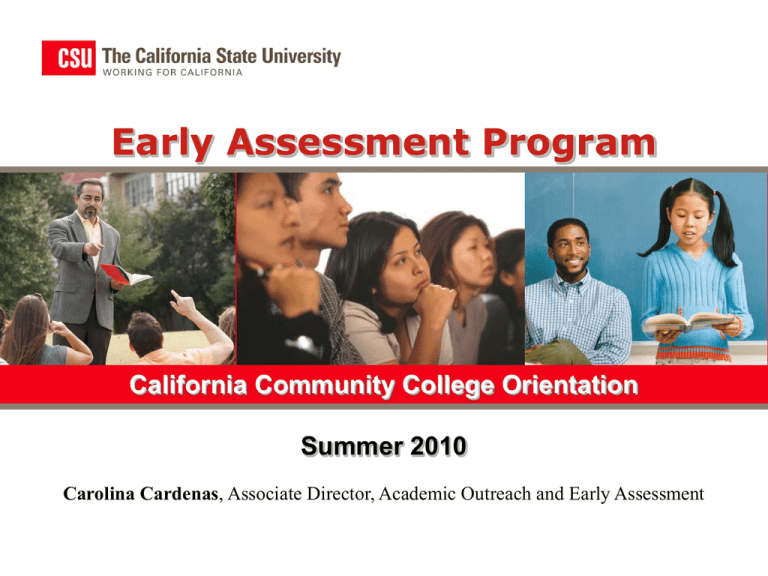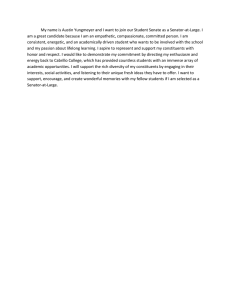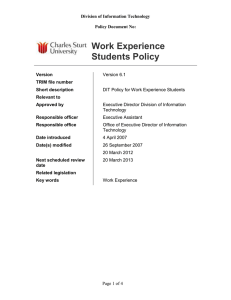Early Assessment Program California Community College Orientation Summer 2010 Carolina Cardenas
advertisement

Early Assessment Program California Community College Orientation Summer 2010 Carolina Cardenas, Associate Director, Academic Outreach and Early Assessment Goals of the EAP Give students an early signal of college readiness Collaborate with the high school community Provide 12th grade interventions The next step is communication of these goals and processes to meet them 2 EAP Audience There are two main types of EAP Constituents: External and Internal. External – – – – – – Students Parents/families Counselors School Administrators Teachers School District Administrators Internal – – – – Outreach Admission Testing/Placement Mathematics/English faculty – Transfer Center Directors – Counseling Center 3 External Constituents Students: mainly an outreach message: – Need to know about the test (what it is-math, English, essay) – Why it’s important (how can it help them) – What the results mean (interpretation) – What they must do when the test is before them i.e. bubble, etc – What they must look for when results arrive (summer) – What they should do with results at the CCC and/or CSU Students receive a letter in February telling them about the test and it’s significance. External Constituents (continued) Parents/families (outreach/motivation message) – Understand the test – Significance – Encourage their son’s/daughters – Relevance/what results mean 5 External Constituents (continued) Counselors/School Administrators – Understand the test and relevance for their students – Importance of communication from school – Data sharing and comparisons – Opportunities for teacher professional development – Testing cycle/test dates – Ordering of testing materials – How results are distributed 6 External Constituents (continued) Teachers – Data sharing – Professional Development opportunities – On-line student resources School District Personnel – Test ordering – Result distribution – Essay test dates *Note on school site test coordinators 7 Internal Constituents Outreach – Understand the test (math, English, essay, bubble) – Why it is relevant/placement – What the results mean/interpretation – What they must look for when results arrive (summer) – What they should do with results at the CCC and/or CSU – Service area schools – Data 8 Internal Constituents (continued) Admission – – – – – Need to know that you are accepting the test Who/how to look up results Confidentiality issues Where the student should be placed Campus contact information 9 Internal Constituents (continued) Testing/Placement & Transfer/Counseling Centers – Need to know that you are accepting the test – Who may look up results – How to look up results – Confidentiality issues – Placement of student – Campus contact information – Next steps for the student 10 Internal Constituents (continued) Mathematics/English faculty (others) – – – – – – – Need to know that you are accepting the test Understanding the test Data sharing Placement of student Research Work on other resource/placement options Campus contact information 11 On-line Resources EAP aggregate data by state, county, district, and school are available online : http://eap2009.ets.org/ http://eap2008.ets.org/ http://eap2007.ets.org/ http://eap2006.ets.org/ 12 Math and English Success Websites www.csuenglishsuccess.org – – – – – www.csumathsuccess.org Free, customized information and tools for students, teachers, and counselors Checklists and guidance tips for parents (English and Spanish) Personalized roadmaps with step by step advice and e-mail reminders Student testimonial videos Online learning tools Personalized Roadmap – – – – Students are encouraged to create a roadmap to receive personalized advice about how to best meet the ELM and EPT Requirements The first step requires students to answer 1-5 questions The questioning process determines what advice the student will be given Over 30 personalized roadmaps can be generated depending on student responses Personalized Roadmap – – – – The roadmap informs students of the series of steps that they should take to become ready for the CSU All information is provided via customized checklists that students can update in real time The roadmap can be printed All items are linked to other pages that provide further detail Student Testimonial Videos Nicole Jason – Videos were shot of students enrolled in developmental math and English courses at Fresno State and Long Beach State – Videos have proven to be an effective motivational tool in convincing high school students to take the CSU placement requirements seriously Online Tools – English and Math Test Prep MATH – – Online practice multiple choice tests (free) ALEKS intelligent tutor online personalized math tutorial ($35) ENGLISH – Online practice multiple choice tests with personalized feedback (free) – Calibrated Peer Review online essay writing tool (free) Educational Results Partnership http://edresults.org/ccag/eap/ CSUDH Approach Train the Trainer Model – TRiO programs advisors and student employees – Center for Careers in Teaching ambassadors Audience driven message – Who needs to know what and when? Fall = Seniors | Spring = Juniors – Quick reference (campus) – FAQ seniors CSUDH Approach Publications – Incorporate EAP message in existing campus and programs publications Advisory Board – Who to invite? AVP of Enrollment Services, AVP of Institutional Research & Analytical Studies, Associate Dean of Students, Associate Dean, College of Education, Director of Academic Advisement, Freshman Program Coordinator, Mathematics Chair, Student Academic Services Director, Outreach Director www.calstate.edu 21

